Analyzing Competitive Strategy: Strategic Tools and Business Growth
VerifiedAdded on 2023/06/12
|8
|1794
|338
Essay
AI Summary
This essay provides an overview of strategic management tools and their application in business development. It focuses on three key tools: PESTEL analysis, Porter's Five Forces, and the Resource-Based View (RBV). PESTEL analysis helps businesses evaluate external market conditions by examining political, economic, social, technological, environmental, and legal factors. Porter's Five Forces analyzes industry dynamics, including the bargaining power of buyers and suppliers, the threat of substitutes, industry rivalry, and the threat of new entrants. The Resource-Based View focuses on a company's tangible and intangible resources and their potential to create a sustainable competitive advantage through heterogeneity, immobility, value, rarity, inimitability, and organization (VRIO). The essay concludes that these strategic tools are essential for informed decision-making and achieving sustainable growth in a dynamic business environment, enabling companies to understand market conditions, identify competitive advantages, and make strategic choices for long-term success. Desklib offers a wealth of resources, including solved assignments and past papers, to aid students in mastering these concepts.
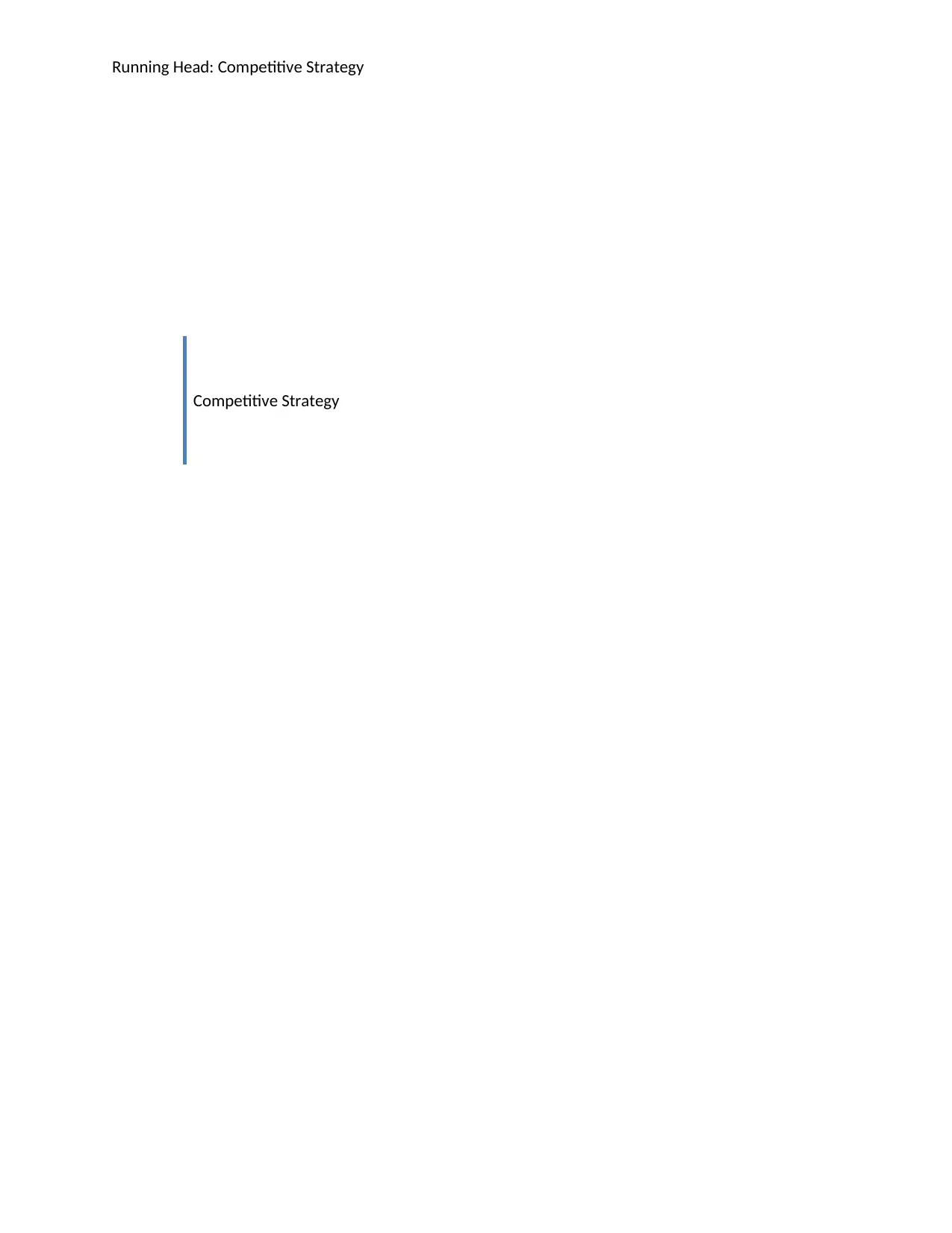
Running Head: Competitive Strategy
Competitive Strategy
Competitive Strategy
Paraphrase This Document
Need a fresh take? Get an instant paraphrase of this document with our AI Paraphraser
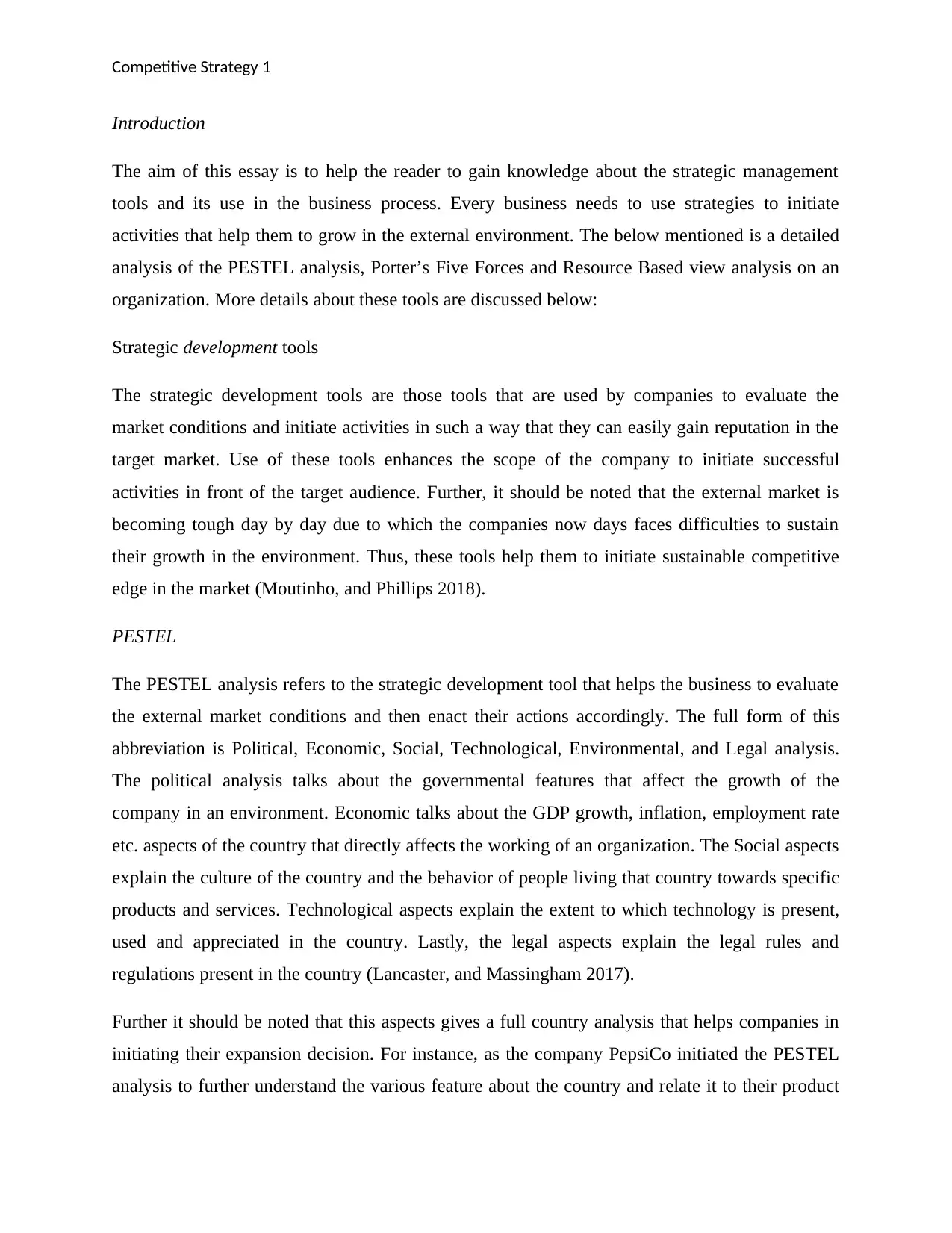
Competitive Strategy 1
Introduction
The aim of this essay is to help the reader to gain knowledge about the strategic management
tools and its use in the business process. Every business needs to use strategies to initiate
activities that help them to grow in the external environment. The below mentioned is a detailed
analysis of the PESTEL analysis, Porter’s Five Forces and Resource Based view analysis on an
organization. More details about these tools are discussed below:
Strategic development tools
The strategic development tools are those tools that are used by companies to evaluate the
market conditions and initiate activities in such a way that they can easily gain reputation in the
target market. Use of these tools enhances the scope of the company to initiate successful
activities in front of the target audience. Further, it should be noted that the external market is
becoming tough day by day due to which the companies now days faces difficulties to sustain
their growth in the environment. Thus, these tools help them to initiate sustainable competitive
edge in the market (Moutinho, and Phillips 2018).
PESTEL
The PESTEL analysis refers to the strategic development tool that helps the business to evaluate
the external market conditions and then enact their actions accordingly. The full form of this
abbreviation is Political, Economic, Social, Technological, Environmental, and Legal analysis.
The political analysis talks about the governmental features that affect the growth of the
company in an environment. Economic talks about the GDP growth, inflation, employment rate
etc. aspects of the country that directly affects the working of an organization. The Social aspects
explain the culture of the country and the behavior of people living that country towards specific
products and services. Technological aspects explain the extent to which technology is present,
used and appreciated in the country. Lastly, the legal aspects explain the legal rules and
regulations present in the country (Lancaster, and Massingham 2017).
Further it should be noted that this aspects gives a full country analysis that helps companies in
initiating their expansion decision. For instance, as the company PepsiCo initiated the PESTEL
analysis to further understand the various feature about the country and relate it to their product
Introduction
The aim of this essay is to help the reader to gain knowledge about the strategic management
tools and its use in the business process. Every business needs to use strategies to initiate
activities that help them to grow in the external environment. The below mentioned is a detailed
analysis of the PESTEL analysis, Porter’s Five Forces and Resource Based view analysis on an
organization. More details about these tools are discussed below:
Strategic development tools
The strategic development tools are those tools that are used by companies to evaluate the
market conditions and initiate activities in such a way that they can easily gain reputation in the
target market. Use of these tools enhances the scope of the company to initiate successful
activities in front of the target audience. Further, it should be noted that the external market is
becoming tough day by day due to which the companies now days faces difficulties to sustain
their growth in the environment. Thus, these tools help them to initiate sustainable competitive
edge in the market (Moutinho, and Phillips 2018).
PESTEL
The PESTEL analysis refers to the strategic development tool that helps the business to evaluate
the external market conditions and then enact their actions accordingly. The full form of this
abbreviation is Political, Economic, Social, Technological, Environmental, and Legal analysis.
The political analysis talks about the governmental features that affect the growth of the
company in an environment. Economic talks about the GDP growth, inflation, employment rate
etc. aspects of the country that directly affects the working of an organization. The Social aspects
explain the culture of the country and the behavior of people living that country towards specific
products and services. Technological aspects explain the extent to which technology is present,
used and appreciated in the country. Lastly, the legal aspects explain the legal rules and
regulations present in the country (Lancaster, and Massingham 2017).
Further it should be noted that this aspects gives a full country analysis that helps companies in
initiating their expansion decision. For instance, as the company PepsiCo initiated the PESTEL
analysis to further understand the various feature about the country and relate it to their product
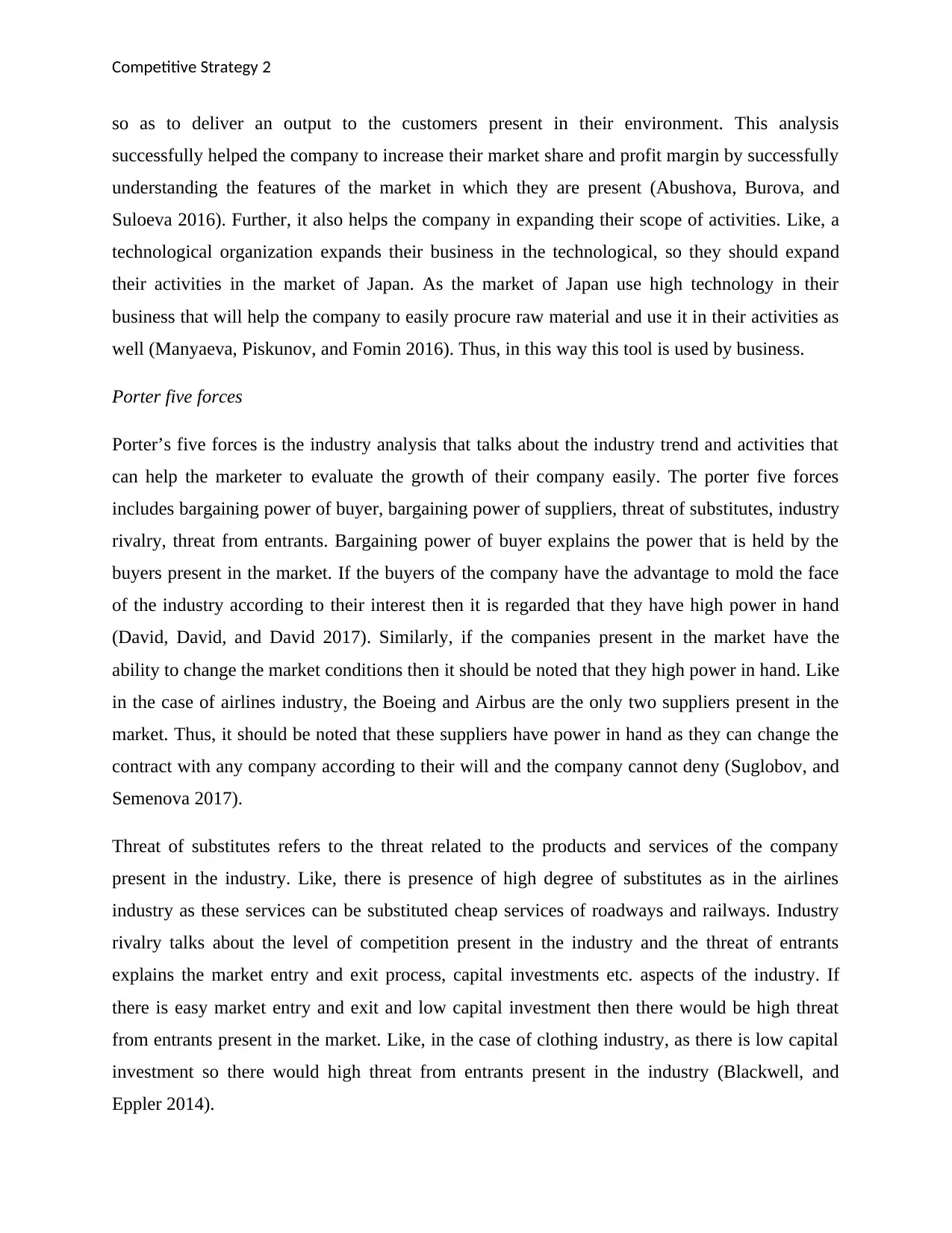
Competitive Strategy 2
so as to deliver an output to the customers present in their environment. This analysis
successfully helped the company to increase their market share and profit margin by successfully
understanding the features of the market in which they are present (Abushova, Burova, and
Suloeva 2016). Further, it also helps the company in expanding their scope of activities. Like, a
technological organization expands their business in the technological, so they should expand
their activities in the market of Japan. As the market of Japan use high technology in their
business that will help the company to easily procure raw material and use it in their activities as
well (Manyaeva, Piskunov, and Fomin 2016). Thus, in this way this tool is used by business.
Porter five forces
Porter’s five forces is the industry analysis that talks about the industry trend and activities that
can help the marketer to evaluate the growth of their company easily. The porter five forces
includes bargaining power of buyer, bargaining power of suppliers, threat of substitutes, industry
rivalry, threat from entrants. Bargaining power of buyer explains the power that is held by the
buyers present in the market. If the buyers of the company have the advantage to mold the face
of the industry according to their interest then it is regarded that they have high power in hand
(David, David, and David 2017). Similarly, if the companies present in the market have the
ability to change the market conditions then it should be noted that they high power in hand. Like
in the case of airlines industry, the Boeing and Airbus are the only two suppliers present in the
market. Thus, it should be noted that these suppliers have power in hand as they can change the
contract with any company according to their will and the company cannot deny (Suglobov, and
Semenova 2017).
Threat of substitutes refers to the threat related to the products and services of the company
present in the industry. Like, there is presence of high degree of substitutes as in the airlines
industry as these services can be substituted cheap services of roadways and railways. Industry
rivalry talks about the level of competition present in the industry and the threat of entrants
explains the market entry and exit process, capital investments etc. aspects of the industry. If
there is easy market entry and exit and low capital investment then there would be high threat
from entrants present in the market. Like, in the case of clothing industry, as there is low capital
investment so there would high threat from entrants present in the industry (Blackwell, and
Eppler 2014).
so as to deliver an output to the customers present in their environment. This analysis
successfully helped the company to increase their market share and profit margin by successfully
understanding the features of the market in which they are present (Abushova, Burova, and
Suloeva 2016). Further, it also helps the company in expanding their scope of activities. Like, a
technological organization expands their business in the technological, so they should expand
their activities in the market of Japan. As the market of Japan use high technology in their
business that will help the company to easily procure raw material and use it in their activities as
well (Manyaeva, Piskunov, and Fomin 2016). Thus, in this way this tool is used by business.
Porter five forces
Porter’s five forces is the industry analysis that talks about the industry trend and activities that
can help the marketer to evaluate the growth of their company easily. The porter five forces
includes bargaining power of buyer, bargaining power of suppliers, threat of substitutes, industry
rivalry, threat from entrants. Bargaining power of buyer explains the power that is held by the
buyers present in the market. If the buyers of the company have the advantage to mold the face
of the industry according to their interest then it is regarded that they have high power in hand
(David, David, and David 2017). Similarly, if the companies present in the market have the
ability to change the market conditions then it should be noted that they high power in hand. Like
in the case of airlines industry, the Boeing and Airbus are the only two suppliers present in the
market. Thus, it should be noted that these suppliers have power in hand as they can change the
contract with any company according to their will and the company cannot deny (Suglobov, and
Semenova 2017).
Threat of substitutes refers to the threat related to the products and services of the company
present in the industry. Like, there is presence of high degree of substitutes as in the airlines
industry as these services can be substituted cheap services of roadways and railways. Industry
rivalry talks about the level of competition present in the industry and the threat of entrants
explains the market entry and exit process, capital investments etc. aspects of the industry. If
there is easy market entry and exit and low capital investment then there would be high threat
from entrants present in the market. Like, in the case of clothing industry, as there is low capital
investment so there would high threat from entrants present in the industry (Blackwell, and
Eppler 2014).
⊘ This is a preview!⊘
Do you want full access?
Subscribe today to unlock all pages.

Trusted by 1+ million students worldwide
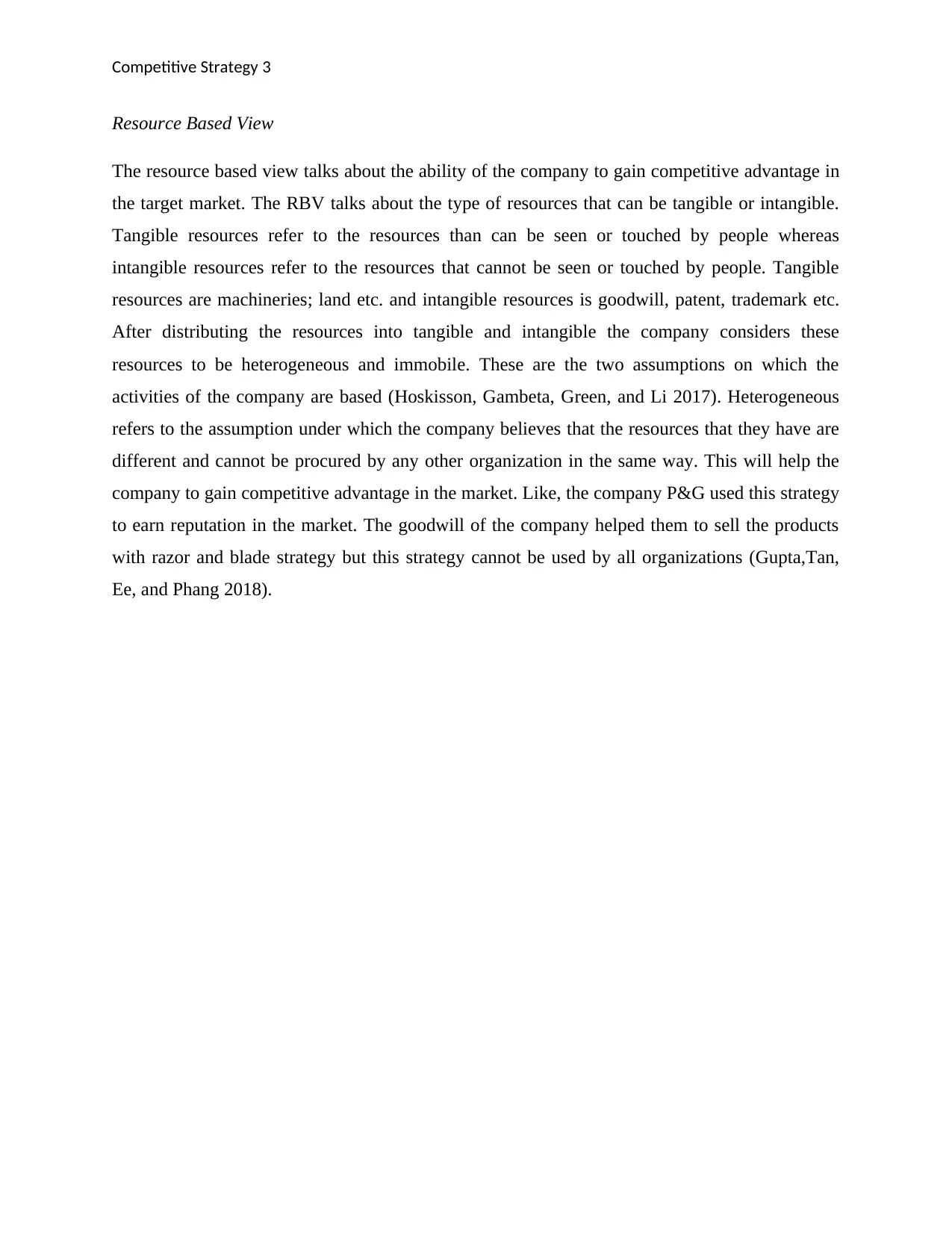
Competitive Strategy 3
Resource Based View
The resource based view talks about the ability of the company to gain competitive advantage in
the target market. The RBV talks about the type of resources that can be tangible or intangible.
Tangible resources refer to the resources than can be seen or touched by people whereas
intangible resources refer to the resources that cannot be seen or touched by people. Tangible
resources are machineries; land etc. and intangible resources is goodwill, patent, trademark etc.
After distributing the resources into tangible and intangible the company considers these
resources to be heterogeneous and immobile. These are the two assumptions on which the
activities of the company are based (Hoskisson, Gambeta, Green, and Li 2017). Heterogeneous
refers to the assumption under which the company believes that the resources that they have are
different and cannot be procured by any other organization in the same way. This will help the
company to gain competitive advantage in the market. Like, the company P&G used this strategy
to earn reputation in the market. The goodwill of the company helped them to sell the products
with razor and blade strategy but this strategy cannot be used by all organizations (Gupta,Tan,
Ee, and Phang 2018).
Resource Based View
The resource based view talks about the ability of the company to gain competitive advantage in
the target market. The RBV talks about the type of resources that can be tangible or intangible.
Tangible resources refer to the resources than can be seen or touched by people whereas
intangible resources refer to the resources that cannot be seen or touched by people. Tangible
resources are machineries; land etc. and intangible resources is goodwill, patent, trademark etc.
After distributing the resources into tangible and intangible the company considers these
resources to be heterogeneous and immobile. These are the two assumptions on which the
activities of the company are based (Hoskisson, Gambeta, Green, and Li 2017). Heterogeneous
refers to the assumption under which the company believes that the resources that they have are
different and cannot be procured by any other organization in the same way. This will help the
company to gain competitive advantage in the market. Like, the company P&G used this strategy
to earn reputation in the market. The goodwill of the company helped them to sell the products
with razor and blade strategy but this strategy cannot be used by all organizations (Gupta,Tan,
Ee, and Phang 2018).
Paraphrase This Document
Need a fresh take? Get an instant paraphrase of this document with our AI Paraphraser
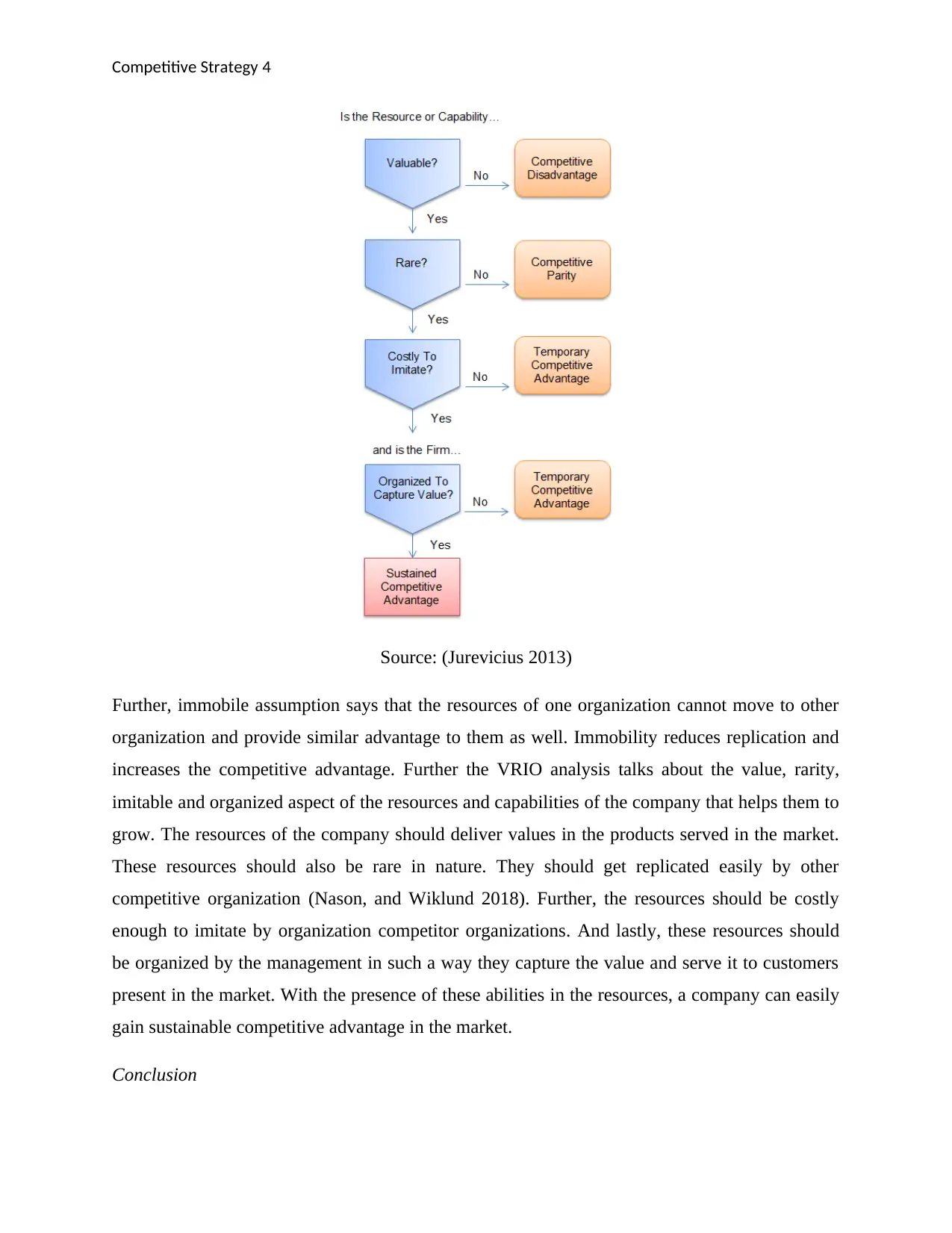
Competitive Strategy 4
Source: (Jurevicius 2013)
Further, immobile assumption says that the resources of one organization cannot move to other
organization and provide similar advantage to them as well. Immobility reduces replication and
increases the competitive advantage. Further the VRIO analysis talks about the value, rarity,
imitable and organized aspect of the resources and capabilities of the company that helps them to
grow. The resources of the company should deliver values in the products served in the market.
These resources should also be rare in nature. They should get replicated easily by other
competitive organization (Nason, and Wiklund 2018). Further, the resources should be costly
enough to imitate by organization competitor organizations. And lastly, these resources should
be organized by the management in such a way they capture the value and serve it to customers
present in the market. With the presence of these abilities in the resources, a company can easily
gain sustainable competitive advantage in the market.
Conclusion
Source: (Jurevicius 2013)
Further, immobile assumption says that the resources of one organization cannot move to other
organization and provide similar advantage to them as well. Immobility reduces replication and
increases the competitive advantage. Further the VRIO analysis talks about the value, rarity,
imitable and organized aspect of the resources and capabilities of the company that helps them to
grow. The resources of the company should deliver values in the products served in the market.
These resources should also be rare in nature. They should get replicated easily by other
competitive organization (Nason, and Wiklund 2018). Further, the resources should be costly
enough to imitate by organization competitor organizations. And lastly, these resources should
be organized by the management in such a way they capture the value and serve it to customers
present in the market. With the presence of these abilities in the resources, a company can easily
gain sustainable competitive advantage in the market.
Conclusion
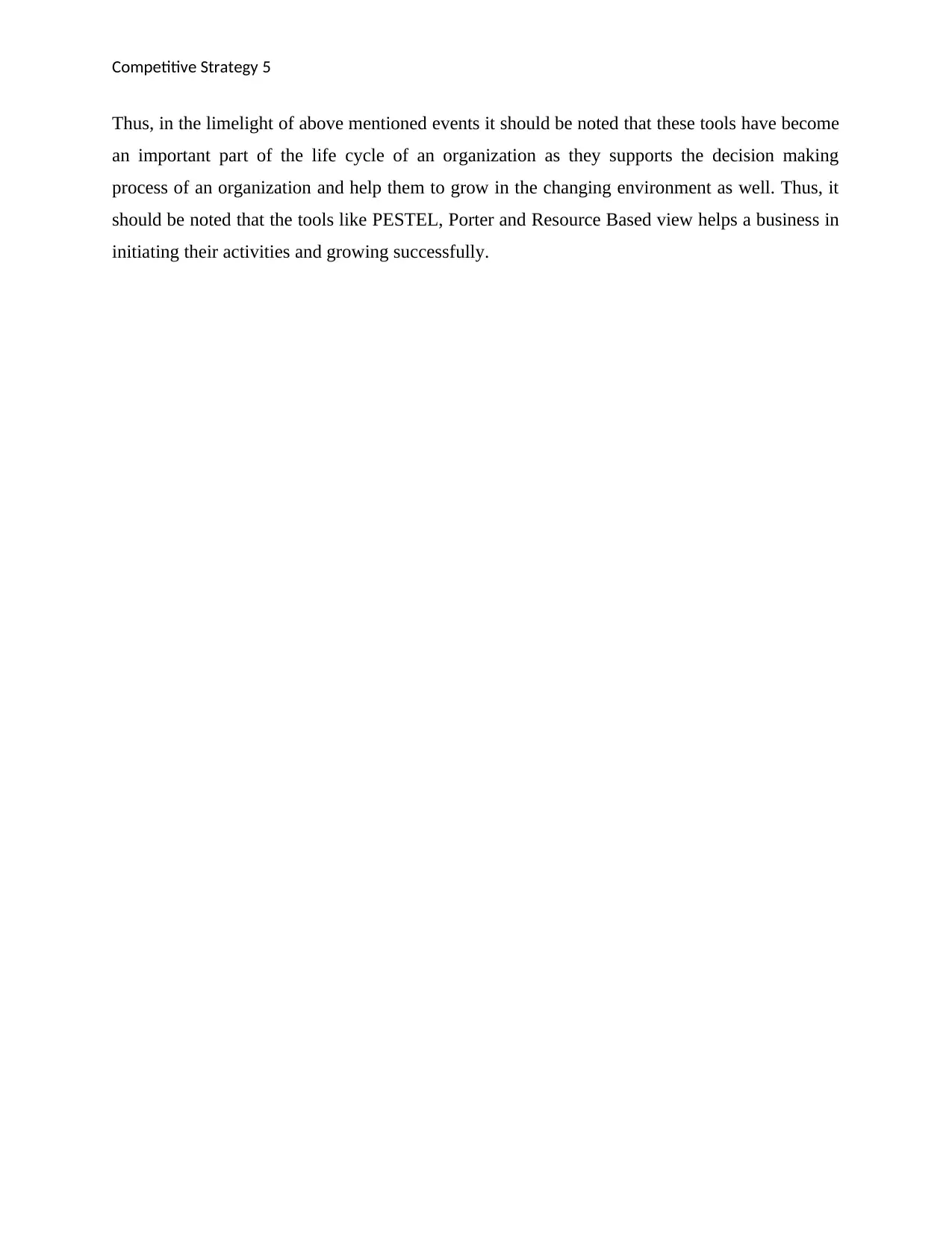
Competitive Strategy 5
Thus, in the limelight of above mentioned events it should be noted that these tools have become
an important part of the life cycle of an organization as they supports the decision making
process of an organization and help them to grow in the changing environment as well. Thus, it
should be noted that the tools like PESTEL, Porter and Resource Based view helps a business in
initiating their activities and growing successfully.
Thus, in the limelight of above mentioned events it should be noted that these tools have become
an important part of the life cycle of an organization as they supports the decision making
process of an organization and help them to grow in the changing environment as well. Thus, it
should be noted that the tools like PESTEL, Porter and Resource Based view helps a business in
initiating their activities and growing successfully.
⊘ This is a preview!⊘
Do you want full access?
Subscribe today to unlock all pages.

Trusted by 1+ million students worldwide
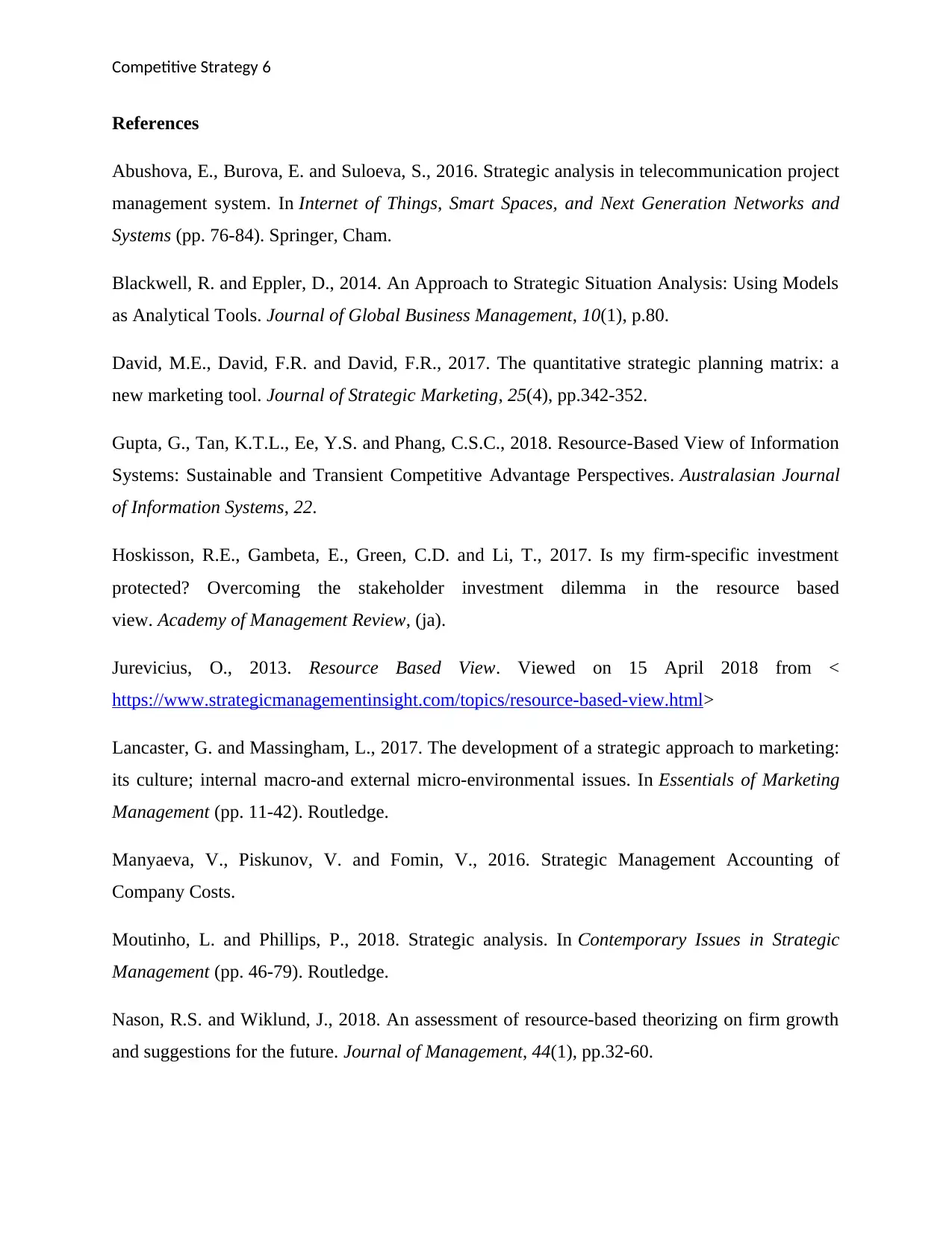
Competitive Strategy 6
References
Abushova, E., Burova, E. and Suloeva, S., 2016. Strategic analysis in telecommunication project
management system. In Internet of Things, Smart Spaces, and Next Generation Networks and
Systems (pp. 76-84). Springer, Cham.
Blackwell, R. and Eppler, D., 2014. An Approach to Strategic Situation Analysis: Using Models
as Analytical Tools. Journal of Global Business Management, 10(1), p.80.
David, M.E., David, F.R. and David, F.R., 2017. The quantitative strategic planning matrix: a
new marketing tool. Journal of Strategic Marketing, 25(4), pp.342-352.
Gupta, G., Tan, K.T.L., Ee, Y.S. and Phang, C.S.C., 2018. Resource-Based View of Information
Systems: Sustainable and Transient Competitive Advantage Perspectives. Australasian Journal
of Information Systems, 22.
Hoskisson, R.E., Gambeta, E., Green, C.D. and Li, T., 2017. Is my firm-specific investment
protected? Overcoming the stakeholder investment dilemma in the resource based
view. Academy of Management Review, (ja).
Jurevicius, O., 2013. Resource Based View. Viewed on 15 April 2018 from <
https://www.strategicmanagementinsight.com/topics/resource-based-view.html>
Lancaster, G. and Massingham, L., 2017. The development of a strategic approach to marketing:
its culture; internal macro-and external micro-environmental issues. In Essentials of Marketing
Management (pp. 11-42). Routledge.
Manyaeva, V., Piskunov, V. and Fomin, V., 2016. Strategic Management Accounting of
Company Costs.
Moutinho, L. and Phillips, P., 2018. Strategic analysis. In Contemporary Issues in Strategic
Management (pp. 46-79). Routledge.
Nason, R.S. and Wiklund, J., 2018. An assessment of resource-based theorizing on firm growth
and suggestions for the future. Journal of Management, 44(1), pp.32-60.
References
Abushova, E., Burova, E. and Suloeva, S., 2016. Strategic analysis in telecommunication project
management system. In Internet of Things, Smart Spaces, and Next Generation Networks and
Systems (pp. 76-84). Springer, Cham.
Blackwell, R. and Eppler, D., 2014. An Approach to Strategic Situation Analysis: Using Models
as Analytical Tools. Journal of Global Business Management, 10(1), p.80.
David, M.E., David, F.R. and David, F.R., 2017. The quantitative strategic planning matrix: a
new marketing tool. Journal of Strategic Marketing, 25(4), pp.342-352.
Gupta, G., Tan, K.T.L., Ee, Y.S. and Phang, C.S.C., 2018. Resource-Based View of Information
Systems: Sustainable and Transient Competitive Advantage Perspectives. Australasian Journal
of Information Systems, 22.
Hoskisson, R.E., Gambeta, E., Green, C.D. and Li, T., 2017. Is my firm-specific investment
protected? Overcoming the stakeholder investment dilemma in the resource based
view. Academy of Management Review, (ja).
Jurevicius, O., 2013. Resource Based View. Viewed on 15 April 2018 from <
https://www.strategicmanagementinsight.com/topics/resource-based-view.html>
Lancaster, G. and Massingham, L., 2017. The development of a strategic approach to marketing:
its culture; internal macro-and external micro-environmental issues. In Essentials of Marketing
Management (pp. 11-42). Routledge.
Manyaeva, V., Piskunov, V. and Fomin, V., 2016. Strategic Management Accounting of
Company Costs.
Moutinho, L. and Phillips, P., 2018. Strategic analysis. In Contemporary Issues in Strategic
Management (pp. 46-79). Routledge.
Nason, R.S. and Wiklund, J., 2018. An assessment of resource-based theorizing on firm growth
and suggestions for the future. Journal of Management, 44(1), pp.32-60.
Paraphrase This Document
Need a fresh take? Get an instant paraphrase of this document with our AI Paraphraser
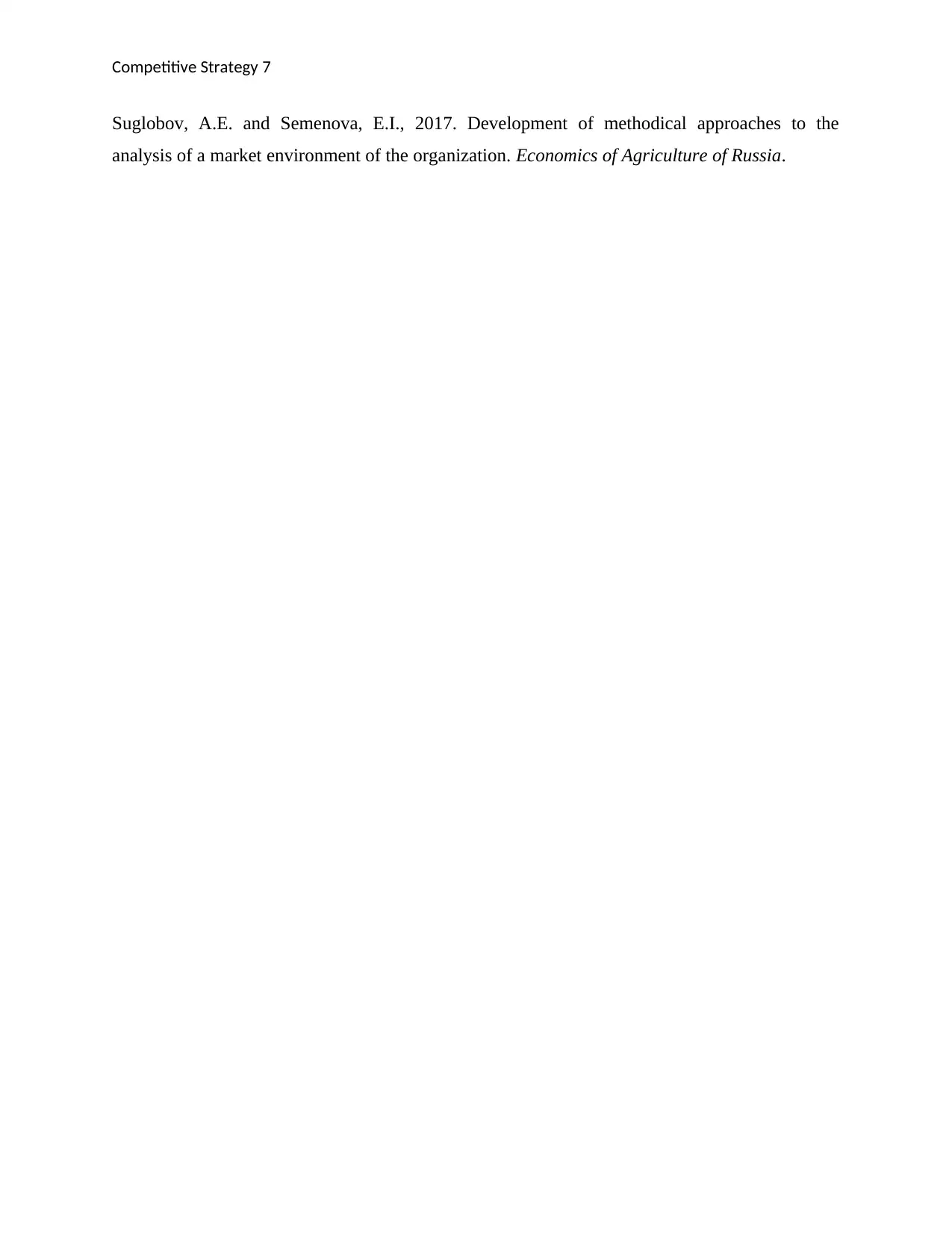
Competitive Strategy 7
Suglobov, A.E. and Semenova, E.I., 2017. Development of methodical approaches to the
analysis of a market environment of the organization. Economics of Agriculture of Russia.
Suglobov, A.E. and Semenova, E.I., 2017. Development of methodical approaches to the
analysis of a market environment of the organization. Economics of Agriculture of Russia.
1 out of 8
Related Documents
Your All-in-One AI-Powered Toolkit for Academic Success.
+13062052269
info@desklib.com
Available 24*7 on WhatsApp / Email
![[object Object]](/_next/static/media/star-bottom.7253800d.svg)
Unlock your academic potential
Copyright © 2020–2025 A2Z Services. All Rights Reserved. Developed and managed by ZUCOL.


